Steelmakers urged to globalise, customise, digitalise
Global steel companies will have to balance efforts focused on globalisation while maintaining an eye on customisation if they are to survive and prosper in a market characterised by excess supply, market concentration and digitalisation, professional services firm EY’s latest yearly global steel report, ‘Globalise or customise: Finding the right balance 2015-2016’ has asserted.
The report, which consituted EY’s fifth yearly analysis and assessment of the risks and opportunities facing companies in the steel sector, cited excess capacity as the biggest challenge in the global steel sector, amid declining growth in global demand, which was driven largely by China.
Much of the surplus capacity, it argued, was attributable to Chinese steel producers, although these were often displacing higher-cost, less-efficient production elsewhere in the world.
According to EY, the Chinese government’s planned rationalisation of its steel sector over the next ten years to deal with excess capacity, pollution, low market concentration and lack of profitability was expected to create a smaller number of large and efficient Chinese steel companies.
“Non-Chinese steelmakers have a small window of opportunity to build competitive advantage before supersized efficient Chinese steelmakers emerge more strongly in the global market.
“To make the most of this opportunity, the sector will need to undergo significant change and transform itself into a far more efficient and competitive sector able to create and retain value and turn profitable,” commented EY global steel leader Anjani Agrawal.
The report further advised global steel players to rationalise excess capacity and encouraged governments to focus on making steel companies more globally competitive rather than providing support in the form of subsidies or temporary trade barriers.
Moreover, investors and capital providers were advised to adopt more dynamic demand forecasting models and robust project appraisal processes.
“Many steel-producing countries still see themselves as isolated or domestic markets, but that is no longer the reality. Low-cost excess capacity in one country is displacing production or sales in another and this is providing incentives for governments to implement regional policies to protect the domestic steel sector or even encourage more capacity,” Agrawal observed.
Despite some consolidation between 1995 and 2005, EY noted that the global steel industry was still relatively fragmented, with the market share of the top ten steelmakers at just 28% – low in comparison with the automotive and seaborne iron-ore markets.
Increasing globalisation was expected to push steelmakers toward greater consolidation to gain economies of scale and benefit from global synergies and to expand product portfolios, extend value chains and access new markets.
“As market concentration increases, it should enable greater pricing discipline, better capacity utilisation and provide greater market power with customers, suppliers and capital providers,” he held.
The report also advised steelmakers to focus on developing premium, value-added, niche downstream products for new sectors or specialty applications, as
leading companies were now collaborating with their customers in the early stages of product development.
“Reconfiguring the supply chain to make it more efficient, while maintaining agility and responsiveness to ever-changing scenarios will be critical for steelmakers to become more competitive,” said Agrawal.
A further emerging trend identified by the report was the evolution towards the digitalisation of the global steel market, with predictive analytics, digital supply chain and the convergence of information communication technology (ICT) and operational technology offering opportunities to develop differentiation, improve decision-making, improve risk resilience and help drive profitable growth.
An “intelligent” connected ecosystem of smart machines, ICT systems, products, logistics and people could foster sustainable competitive advantage for steel companies and their stakeholders.
“Digital is one of the defining megatrends right now but most steelmakers are yet to harness it to develop new ways of working,” he noted.
Comments
Press Office
Announcements
What's On
Subscribe to improve your user experience...
Option 1 (equivalent of R125 a month):
Receive a weekly copy of Creamer Media's Engineering News & Mining Weekly magazine
(print copy for those in South Africa and e-magazine for those outside of South Africa)
Receive daily email newsletters
Access to full search results
Access archive of magazine back copies
Access to Projects in Progress
Access to ONE Research Report of your choice in PDF format
Option 2 (equivalent of R375 a month):
All benefits from Option 1
PLUS
Access to Creamer Media's Research Channel Africa for ALL Research Reports, in PDF format, on various industrial and mining sectors
including Electricity; Water; Energy Transition; Hydrogen; Roads, Rail and Ports; Coal; Gold; Platinum; Battery Metals; etc.
Already a subscriber?
Forgotten your password?
Receive weekly copy of Creamer Media's Engineering News & Mining Weekly magazine (print copy for those in South Africa and e-magazine for those outside of South Africa)
➕
Recieve daily email newsletters
➕
Access to full search results
➕
Access archive of magazine back copies
➕
Access to Projects in Progress
➕
Access to ONE Research Report of your choice in PDF format
RESEARCH CHANNEL AFRICA
R4500 (equivalent of R375 a month)
SUBSCRIBEAll benefits from Option 1
➕
Access to Creamer Media's Research Channel Africa for ALL Research Reports on various industrial and mining sectors, in PDF format, including on:
Electricity
➕
Water
➕
Energy Transition
➕
Hydrogen
➕
Roads, Rail and Ports
➕
Coal
➕
Gold
➕
Platinum
➕
Battery Metals
➕
etc.
Receive all benefits from Option 1 or Option 2 delivered to numerous people at your company
➕
Multiple User names and Passwords for simultaneous log-ins
➕
Intranet integration access to all in your organisation



















